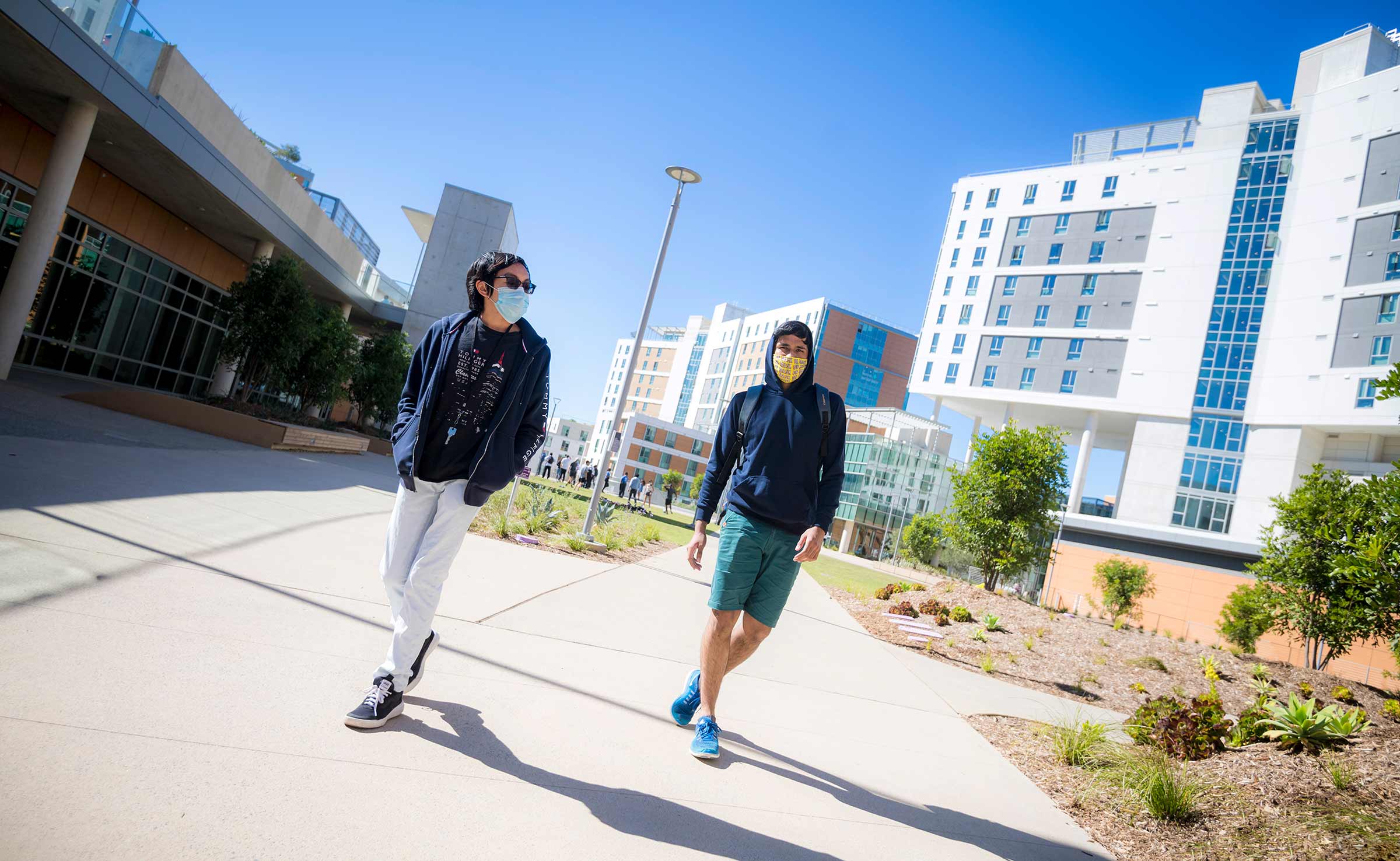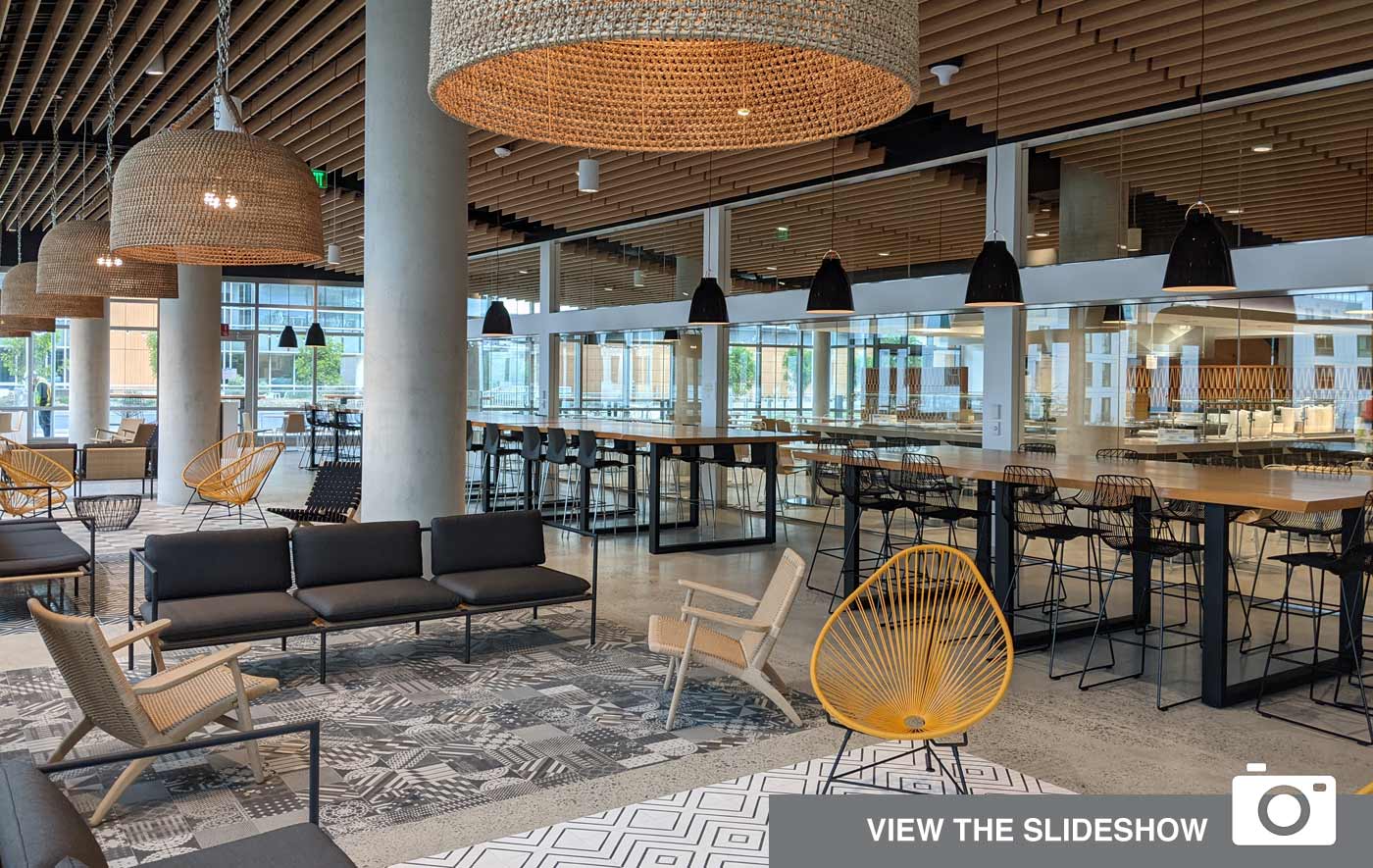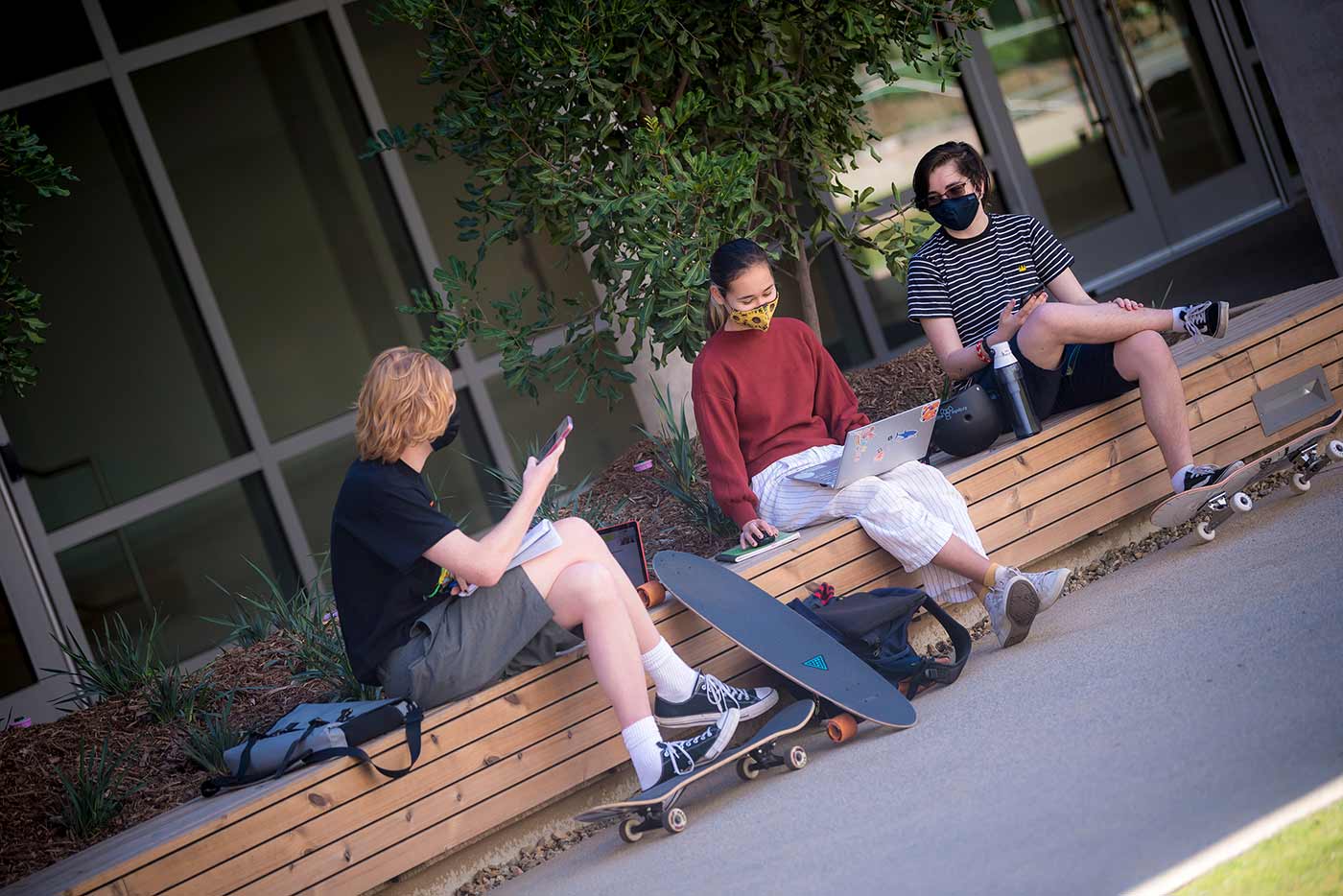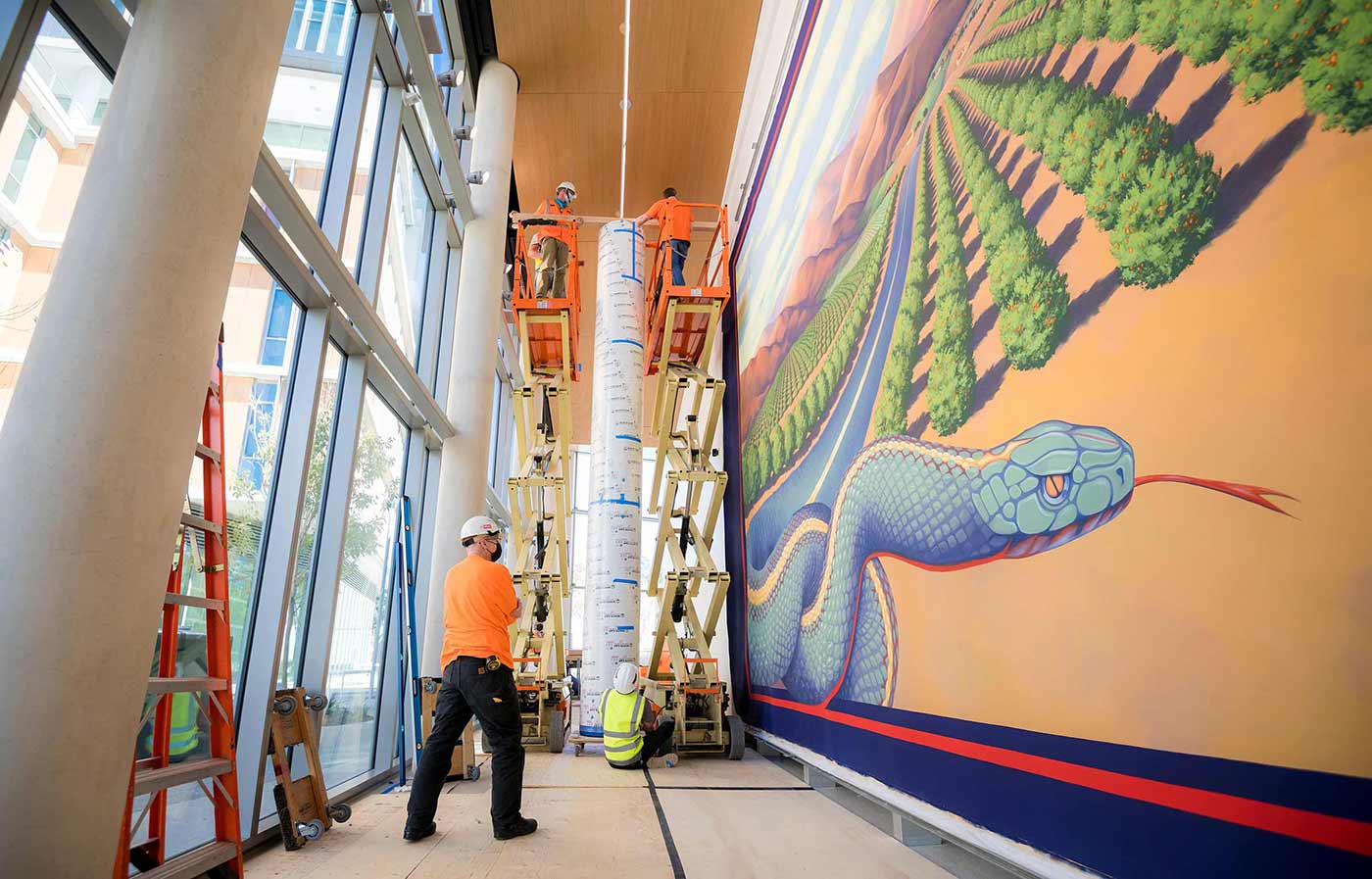By:
- Leslie Sepuka
Published Date
By:
- Leslie Sepuka
Share This:
North Torrey Pines Living and Learning Neighborhood Springs to Life

Students in the center of the campus’s first living and learning neighborhood. Photo by Erik Jepsen/UC San Diego Communications.
After welcoming students to the west side residential areas in the fall, the east side of North Torrey Pines Living and Learning Neighborhood is starting to spring to life. This quarter, the UC San Diego Craft Center welcomed the campus community to meet its new instructors, a three-story HDH dining area with five restaurants and a market brought flavors from across the globe, Sixth College administration and two academic divisions settled into their new spaces and the Stuart Collection’s “Same Old Paradise” was installed in its home in the heart of the neighborhood—all of which contributed to making the vision of the university’s first living and learning neighborhood a reality.
“With each new milestone, our vision of serving students and making our campus a preferred destination for the greater community is strengthened,” said UC San Diego Chancellor Pradeep K. Khosla. “UC San Diego is where students come to explore, discover and grow; where scholars and researchers collaborate to solve society’s most challenging problems; and where our community comes to recharge, expand their knowledge, and experience art, culture and recreation.”

A three-story, light-filled, building in North Torrey Pines Living and Learning Neighborhood features five new exceptional campus dining options and a market. Photo credit: UC San Diego.
Connection and creativity at the Craft Center
A team of artist instructors have joined UC San Diego Craft Center Manager Annika Nelson to support hands-on art classes in the five core Craft Center programs of ceramics, jewelry-making, woodworking, surfboard shaping and culinary arts. The Craft Center sparked a conversation on Instagram, Facebook and their website, and recently invited the campus community to meet some of the new instructors and participate in hands-on workshops during a virtual event.
“It was an exciting challenge to think about how to bring a studio experience to a virtual environment,” said Craft Center artist-instructor Susan Wickstrand. “Through this reimagining, I discovered that creativity is not limited, the art is not compromised and we were able to connect with people we may not have reached otherwise.”
Delicious and healthy dining, 2Go
A three-story, light-filled, nearly 20,000-square-foot building with the largest market on campus, Sixth Market, is now open, bringing five new exceptional campus dining options.
- Makai, which means “toward the sea,” features fresh fish and poke bowls
- Noodles focuses on Asian noodle-, grain- and dumpling-based soups
- Crave offers plant-forward entrees with an option to add meat or other proteins from the grill
- Wolftown pairs global street food with a classic taqueria
- The Rooftop features an outdoor mesquite grill and smokehouse
The campus community can get a first look at all the tantalizing offerings on the menus and order online via the Triton2Go app. Faculty and staff can now take advantage of the Triton2Go program by using Triton Cash. Simply follow the instructions for downloading the app, and upon checkout, select Triton Cash under campus cards for the payment method.
Over the spring and summer, look for additional retail restaurant openings along the Ridge Walk on the east side of the Neighborhood.
One college administration and two academic divisions
Sixth College administration and the Divisions of Social Sciences and Arts and Humanities have moved into three new academic buildings that support instruction, engagement and collaboration.
Sixth College has helped to make the neighborhood a live-learn lab. From its inception, the project team explored issues around student health and well-being, interviewing Sixth College students about which elements of their environment contributed positively and negatively to their college life. The insights gained relating to the student experience contributed significantly to the design and formed the foundation for an ongoing program in which living and learning neighborhoods can function as live-learn labs, where students can engage with and enhance their environments via curriculum. Elinor Oren, a UC San Diego sophomore studying Real Estate and Development and living at North Torrey Pines Living and Learning Neighborhood, conducts and advances the study as the project’s first Live-Learn Fellow.
“Sixth College is excited to have its students advance this process of discovery and learning,” said Lakshmi Chilukuri, UC San Diego’s Sixth College Provost. “It fits in very well with our motto of being innovative, interconnected and aware, and we hope it will inform future design processes.”

The neighborhood expands opportunities for students to fully integrate into the academic and social life of the campus, and to be close to research, social support, cultural and recreation facilities.
The Arts and Humanities Building brings together for the first time the Office of the Dean, the departments of Philosophy, History and Literature, the Institute of Arts and Humanities and the Analytical Writing Program. In 2017, the Division of Arts and Humanities received a first-of-its-kind Capacity Building and Challenge Grant from the National Endowment for the Humanities to directly support construction of the new location for the Institute of Arts and Humanities. At the time of the announcement, Arts and Humanities Dean Cristina Della Coletta called the support a “catalyst” and said, “a top, public university serves its students best by giving them a well-rounded…education that includes arts and humanities.” As the division completes its move into the neighborhood, the matching portion of the grant has been met.
Social Sciences’ Public Engagement Building features open spaces—“spaces intentionally designed for flow and interaction, for hands-on learning and collaboration,” said Dean Carol Padden—where social scientists will continue to do the science of society, working on pressing social issues in partnership with community organizations and members of the broader public. The building includes two of the division’s outreach-intensive departments, Education Studies and Urban Studies and Planning as well as several of its publicly engaged research centers and initiatives. The Black Studies Project and the Yankelovich Center for Social Science Research, for example, are calling the building home and will share conference areas. CREATE, an educational equity research and outreach center, will keep doing its impactful work out of the PEB, and the newest divisional initiative, the Climate Action Lab, is launching from the incubator space. A teaching preparation lab and a geographic information systems (GIS) lab will also help faculty and students to analyze and address real-world problems.
A unique home for monumental art
A 22- by 62-foot mural, “Same Old Paradise,” by Alexis Smith, references the search for paradise. It depicts a road transforming into an immense snake within a landscape of California hills and orange groves. The work also features eight framed collages reflecting the thoughts of Sal Paradise, the main character in Jack Kerouac’s autobiographical novel, “On the Road.” The mural, which is the first painting to be included in the Stuart Collection, was the inspiration for the iconic “Snake Path,” which was installed in 1992.

North Torrey Pines Living and Learning Neighborhood is the long-awaited home for a 22- by 62-foot mural, “Same Old Paradise,” by Alexis Smith. Photo by Erik Jepsen/UC San Diego Communications.
The mural was originally made in 1986 for the Brooklyn Museum lobby in New York as a temporary commission, and has been in storage for 30 years. Smith had promised to donate the work to the university, but its size made it a challenge to find a proper place. When planning for the North Torrey Pines Living and Learning Neighborhood began, an auditorium was identified as an ideal location for the monumental mural. It can be seen from the terrace outside as well as the inside corridor, situated in the heart of the campus’s first Living and Learning Neighborhood.
“I had seen the mural in 1987, but unrolling the giant work when it arrived here was very emotional, we all shed some tears,” explained Mary Beebe, director of the Stuart Collection. “We were astounded by the pristine condition. Seeing the mural up close is like entering the landscape itself, with the orange trees aligning and realigning in the way they do when one speeds along a highway.”
Beebe continued, “Alexis is deeply happy to have found a real home for this mural. Suddenly, there is this auditorium wall that is absolutely perfect for it, close to the Snake Path.”
Smart parking options
The new Scholars Parking Structure at North Torrey Pines Living and Learning Neighborhood is open. Innovative parking sensors have been installed to provide in-garage parking guidance and real-time parking information, which will soon be available in the campus app. A, B, SR and V parking permits are honored in all unmarked spaces. Visitors and campus affiliates can park for just $1.50/hour with the first hour free and a $6 daily maximum when using the Parkmobile app and zone number 4752.
Looking forward
There is more to come in support of the university’s vision to make our campus a welcoming destination and a live, learn, play environment. As the east side of North Torrey Pines Living and Learning Neighborhood starts to spring to life, the university’s second living and learning neighborhood, the Theatre District Living and Learning Neighborhood, has started construction with the goal of opening in the fall of 2023.
The neighborhood is being built on parking lots adjacent to UC San Diego’s Joan and Irwin Jacobs Theatre District—home to multiple performance spaces used by both the Department of Theatre and Dance and La Jolla Playhouse. Primarily consisting of undergraduate housing, the neighborhood is designed to bring enhancements to students while supporting the university’s goal of improving the visitor experience for theatre patrons and highlighting UC San Diego’s arts presence in the community. The project has already earned recognition in 2020 with a Design Award from American Institute of Architects (AIA) San Diego.
Share This:
You May Also Like
Engineers Take a Closer Look at How a Plant Virus Primes the Immune System to Fight Cancer
Technology & EngineeringStay in the Know
Keep up with all the latest from UC San Diego. Subscribe to the newsletter today.



